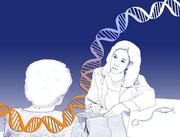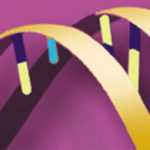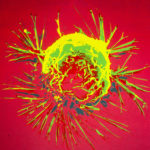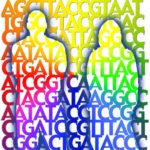Let’s Slow the Race to Sequence Everyone’s Genome: 3 Views
Direct-to-consumer (DTC) genetic-testing is apparently here to stay, and will likely soon give way to exome and genome sequencing for all. Yesterday I got an email from a sequencing company offering to do an exome for $750 — research, not DTC, but the lowest price I’ve seen.
Just as I wouldn’t read all of Wikipedia to learn about hippos, do we really need all the genetic information about ourselves that we can possibly get? I don’t think so.
Organizations such as the American College of Medical Genetics (ACMG) are releasing lists of “incidental findings” actionable enough to give to physicians whose patients have their exomes sequenced in search of a diagnosis. But restricting reporting of genetic information might soon be a little like forbidding people from taking photos with their cell phones when everyone’s already able to do it. Horse out of barn; cat out of bag. Last year’s American Society of Human Genetics annual meeting was all about the incidentals and what to do with them, yet when I pitched the idea right after to a major magazine, complete with cases of patients seeking one diagnosis and finding another, the editors just didn’t get it. Now they do.
A PRECEDENT FROM A PRIVATE MEDICAL PRACTICE
Recently, the ob/gyn practice where I provide genetic counseling received a notice from the lab that supplies the genetic test panel for cystic fibrosis (CF) that we give to all pregnant patients. The lab is reducing the number of mutations screened from 97 to 23.
Why? Because not all mutations are created equal. Some are “VOUS” – “variants of uncertain significance.” They’re not wild type (aka normal), but also not associated with a problem.
“Most of the rare CF mutations reported have little evidence supporting whether they are serious, mild, or have any clinical significance,” read the lab’s note. The average patient, who might not realize that a gene can vary in many ways, might make an irreversible reproductive decision based on a test result that isn’t dire at all. This happened with a mutation called I148T that turned out to cause CF only if the chromosome 7 that bears it also has a second mutation, which wasn’t tested for. The ACMG yanked I148T from the test panel. Detecting it could do more harm than good.
The matter of meaning is important for other conditions. For a woman of Ashkenazi descent with a family history of breast and ovarian cancer, for example, it makes more sense to initially test for the three common Ashkenazi mutations in the BRCA1 and BRCA2 genes, than to shell out $3400+ to sequence the entire genes right away. Doing so can result in a VOUS situation – something unusual, meaning as yet unknown. That’s a prescription for anxiety. A woman with a strong family history wouldn’t need a DNA test to tell her to have frequent mammograms and do breast self exams.
A VIEW FROM ACADEMIC MEDICINE
At the same time that a lab is restricting tests to the most common and meaningful CF mutations, a small study on direct-to-consumer genetic testing confirms that the average medical consumer may place too much value on DNA information. It seems that genetic determinism – the idea that our genes permanently set everything about us – is alive and well.
The Journal of Community Genetics published a report from Katherine Wasson, PhD, MPH, and colleagues at Loyola University Chicago Stritch School of Medicine on the results of following 20 self-selected primary care patients from an urban medical center taking 23 and Me’s widely-used genetic test panel. The study was intended to simulate someone sending a spit sample to a company and receiving results at home, but the medical setting and especially the involvement of an in-the-flesh genetic counselor didn’t quite echo the experience of reading potentially disturbing disease risk estimates on one’s computer screen. In fact, only one participant claimed to have been able to understand the results without the help of the genetic counselor.
At least in this small sampling of folks willing to take DTC genetic tests, hope and blind faith seemed to have trumped knowledge of the science or of what medicine can do about the results. Some comments from the participants on their testing experience:
“If you know that there’s something going on you can go ahead and fix it now and not have to try to fix it later when it’s already unfixable.”
“I know I’ll be around at least another year or two.”
“It’s as if you stepped into a time capsule and you went ahead and you can see something,”
Can the sheer sexiness of the idea of high-tech genetic testing blind people to the fact that they can perish of an infection in a short time, or be hit by a bus or struck by lightning?
OPPOSITE VIEWS FROM TWO FRIENDS
Peter Kent, who heads up a biotech company in upstate New York, was trying to decide when to start drawing Social Security payments. When he retires at 66, or delay until 70 and get more? The decision would depend on his health.
Being an engineer, Peter calculated that it would pay to wait until 70 if he knew he’d live until 84, and that info would also help him decide whether to buy long term care insurance. “I seem active and healthy, but is this a good bet?” he wondered.
Peter used Realage.com to learn that his health made him 9 years healthier than the calendar would indicate. He’s also a genealogy buff, and factoring in the ages of his relatives, combined with a family tree with more than 1000 leaves including ages at death, he concluded that he’d live a long time. But DNA evidence would add assurance. So Peter drove his and his wife’s spit to Vermont, because New York doesn’t allow individuals to take 23andMe’s tests.
He was happy with the results. “I have a somewhat elevated risk for 26 issues, decreased risk for 28 issues, and normal risk on 57 issues, with various levels of confidence in these estimates. Nothing alarming.” That’s a bit too nebulous for me, but the company’s tests can alert someone to seek further testing. I’m sure they’ve saved lives.
Peter’s DNA results were practical. Inherited risk for type 2 diabetes is keeping him exercising. Two markers suggest he’ll live to age 95-100, and that he likely won’t go bald. If given heroin or morphine, he might easily become addicted. Plus, his eyes should be blue. Testing isn’t perfect.
For Peter, genetic testing was both informative and fun. That wasn’t the case for my friend. Her 18-year-old son had taken the 23andMe test panel, out of curiosity, and discovered a BRCA1 mutation in the family. (Yes, 23andme included the common BRCA mutations despite Myriad Genetics‘ claim of gene ownership.)
Finding the BRCA1 mutation was a shock, and inconsistent with the family history of just a few cancers in older folk, none of whom were from the high-risk population groups. Myriad testing confirmed that the 18-year-old had inherited the mutation from his father, and the family is still wrestling with who to tell. My friend wishes her son had never taken the test — she wanted the choice not to know, but genetics doesn’t always work that way.
Unexpected genetic test results require interpretation and communication based on a thorough knowledge of genetic science, which many health care professionals do not yet have. Logic enters the diagnostic picture as well.
We don’t often hear about people with mutations who don’t have the associated illness – they wouldn’t come to a physician’s attention. And if they did, many physicians, given the lightning speed of the average exam, wouldn’t do a thorough enough history to reveal a pattern of inheritance. The 18-year-old’s dad’s doc initially refused to send his sample to Myriad for BRCA testing because he didn’t think a male could pass on a breast cancer gene! Autosomal inheritance, hello?
MUTATIONS IN CONTEXT
Putting on my genetics textbook author hat, I bring up the very old concept of incomplete penetrance: a particular genotype does not always cause the associated phenotype. You can inherit a BRCA1 mutation and never develop cancer. This is where ancestry comes into play.
 Angelina Jolie is in a high-risk population group, French-Canadian, as is filmmaker Joanna Rudnick, who has a Jewish background. Both inherited mutations that gave them a risk of up to about 87% that they’d develop cancer — not 100%, but certainly high enough to make prophylactic surgery an option.
Angelina Jolie is in a high-risk population group, French-Canadian, as is filmmaker Joanna Rudnick, who has a Jewish background. Both inherited mutations that gave them a risk of up to about 87% that they’d develop cancer — not 100%, but certainly high enough to make prophylactic surgery an option.
Jolie had surgery before she developed cancer and Rudnick was awaiting surgery when she found a lump that turned her risk into reality, proving cancerous. She’d waited after receiving genetic test results to have her children. Had these women who’ve bravely told their stories come from different ancestry groups, their risks might have been lower.
Penetrance is “incomplete,” as geneticists say, due mostly to the influence of other genes. And that’s been my primary argument for not acting on genetic test results in low penetrance situations in the absence of clinical data. That’s what some parents-to-be did based on reports of CF mutations that turned out to be harmless. Multiple these issues arising from testing for variants of single genes by the number of genes in the human genome, and the looming problem of information overload is clear.
My three comparisons – a medical practice advised to restrict the number of mutations in one gene (CFTR) to those most likely to occur and cause disease, a study finding that patients think genetic tests predict their futures, and the experiences of my two friends – indicate that the days of exome/genome sequencing for all may be coming way too fast.
The human genome is not a perfect crystal ball, and the environment and the crosstalk among genes profoundly influence which tendencies will translate into clinical reality. Perhaps we should sequence and store, delivering only the actionable information until researchers have had the time to annotate everything and work out the gene-gene and gene-environment interactions.
Let’s take the time to more fully understand how our genes influence each other before we bow to genetic determinism and place our entire futures at the mercy of our sequences of A, C, T and G.





Good cautionary piece. But I can’t help thinking that what’s really needed is more better education and communication. Besides, how will we ever learn more about these variants of unknown significance without the genome sequences from lots of otherwise healthy people? I disclose that I had my exome sequenced, and I and my family had 23andMe genotyping. I use my own genome data to teach my students (both first-year college students and graduate students) about human genetics, genetic testing, and the current limits of such data and interpretation.
Thanks, Jung, I agree, we need many “healthy” genomes. The education and communication would determine exactly what individuals can elect to learn about their sequences. I wrote the piece because I was alarmed at the comments from the participants in the 20-person study, they didn’t even think that maybe something other than genetics can kill you.
Having read this blog piece I keep thinking about where there might be a website or data warehouse that one could log their data. This to help the world better understand more about our genes. It would be freely available data to parse, sort and download and then post any findings that you may want to share and or discuss in a forum on this same website. Is there such a place? I am not a student or a teacher but one who tries to follow current events in health and scientific advances thereof. I’m thinking also that one could post anonymously their data or keep their credentials confidential, make it an option.
I have been tempted many times to get a test done and am now thinking about doing so again after reading this. Money is the only thing standing in the way though. I will have to budget for such a thing. Thank you for your blog!
Hi Paul. I don’t know about a voluntary deidentified database — great idea. Maybe someone will chime in? I’m still deciding whether to have mine “done” too. I think the cost is going to come way down — it already has — so exome/genome sequencing may become more widely available I think within the next 5 years. I worry about how the medical community will keep up and embrace the technology. I recently wrote about this on Medscape — but also have recently had some personal encounters with physicians who made some grievous errors with run-of-the-mill non-genetic problems. Worrisome. So much to know.
I am very much in favor of “get all the information we can!!!!!”, but everybody needs to remember that most of genetics is simply not yet understood and probably will not be well understood in the lifetime of nearly everyone alive today. Until we do understand how genes do their thing we also need to remember that genetics is about possibility and not certainty. Other genes, epigenetics, and your body’s exome can all have dramatic effects on the nature and degree to which a particular gene will influence your life.
A good way to think of this is to listen to a variety of musical pieces that are a variation upon a theme – someone with musical talent can hear the similarities between the pieces, but someone who is simply enjoying the music hears pieces that encompass a lot of musical diversity. Gene expression is very much the same, there are genetic themes to how you lead your life, but each life is unique and different.
Thank you — a very eloquent and thoughtful take on the situation.
Hi Ricky! We, at Lynch Syndrome International, are seeing many with the gene mutations who are not getting the cancers, thankfully to regular cancer screenings. In fact of the over 4,000 families involved with our organization, we know of only 17 persons we have lost in the last four years.
Physicians are rapidly learning about Lynch syndrome and are doing a great job of diagnosing patients, alongside genetics professionals, however, there is a strong move to revert back to the 1990s to mid 2000s, whereupon only a select group was involved in the diagnosis process. Only 5% of us were diagnosed, then and many died.
We believe everyone needs to work together and “play nice,” with one another, therefore, providing a great benefit of the patient, not the benefit of the medical and genetics profession. There are many voices to blend, all with a valuable contribution.
The enhanced mortality of today is an incredible change from the generations before us, when entire generations and families were essentially “wiped out,” however, there is still a very long way to go, with patients’ rights, respect for patient choice, insurance company mandates, privacy issues of genetics, quality genetic tests, respect for the patient, respect for the families, quality research from the U.S., etc.
Since we have instituted public awareness and education, on a mass level, diagnoses have dramatically increased and patients have a choice and empowerment in their future. In short, today, there is hope.
Love reading your blog…keep up the good work.
Warm regards,
Linda Bruzzone
Lynch Syndrome International
Thank you for the information! What is “enhanced mortality”? (I’m Ricki, a she, not Ricky). Thanks for reading the blog and congrats on all your great work.
Gotcha! Its Ricki with an “i”….
“Enhanced mortality” is an awkward term, isn’t it? Perhaps the better term would be enhancement in longevity of life?
Nonetheless, as a result of genetic testing and regular cancer screenings, today, we live! And, that’s a good thing!